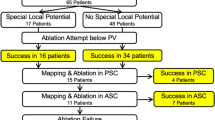Abstract
Background
Ablation of outflow flow ventricular arrhythmia (VA) originating from aortic cusps can be challenging. The aim of this study was to describe our approach for this ablation.
Methods
All patients with outflow VA suspected to originate from aortic cusps according to ECG or after failed ablation from right ventricular outflow tract (RVOT) underwent cardiac CT and radiofrequency ablation. CT image of aortic cusps and coronary arteries was integrated into electroanatomic mapping system by point (left main ostium)-based registration. Ablation was performed at the earliest activation site.
Results
Ten patients were included in this case cohort. The ablation catheter was easily maneuvered above and below the aortic valve after registration. Two patients who had previous failed ablation of RVOT focus had successful ablation at right coronary cusp (RCC) and at left coronary cusp (LCC). A patient who had previous failed ablations of RVOT and LCC focuses had successful ablation at RCC-LCC junction. A patient who had previous failed ablation at LCC had successful ablation at RCC-LCC junction. Three patients had successful ablation at RCC-LCC junction, and one patient at LCC. One patient had successful ablation at anterior interventricular vein–great cardiac vein junction. One patient had successful ablation at non-coronary cusp. During follow-up (12–30 months), one patient had recurrence of VA controlled by flecainide. The remaining patients were free of VA without medications.
Conclusions
Catheter ablation of VA originating from aortic cusps is safe and effective. CT image integration into electroanatomic mapping system can be helpful in this challenging ablation.





Similar content being viewed by others
References
Hutchinson, M. D., & Garcia, F. C. (2013). An organized approach to the localization, mapping, and ablation of outflow tract ventricular arrhythmias. Journal of Cardiovascular Electrophysiology, 24, 1189–1197.
Vaidya, V., Syed, F., Desimone, C., Bdeir, S., Munoz Fdel, C., Packer, D. L., et al. (2013). Outflow tract ventricular tachycardia mapped to the coronary arteries: anatomical correlates and management strategies. Journal of Cardiovascular Electrophysiology, 24, 1416–1422.
Suleiman, M., & Asirvatham, S. J. (2008). Ablation above the semilunar valves: when, why, and how? part I. Heart Rhythm, 5, 1485–1492.
Bala, R., Garcia, F. C., Hutchinson, M. D., Gerstenfeld, E. P., Dhruvakumar, S., Dixit, S., et al. (2010). Electrocardiographic and electrophysiologic features of ventricular arrhythmias originating from the right/left coronary cusp commissure. Heart Rhythm, 7, 312–322.
Kamioka, M., Mathew, S., Lin, T., Metzner, A., Rillig, A., Deiss, S., et al. (2015). Electrophysiological and electrocardiographic predictors of ventricular arrhythmias originating from the left ventricular outflow tract within and below the coronary sinus cusps. Clinical Research in Cardiology, 104, 544–554.
Ouyang, F., Mathew, S., Wu, S., Kamioka, M., Metzner, A., Xue, Y., et al. (2014). Ventricular arrhythmias arising from the left ventricular outflow tract below the aortic sinus cusps: mapping and catheter ablation via transseptal approach and electrocardiographic characteristics. Circulation. Arrhythmia and Electrophysiology, 7, 445–455.
Betensky, B. P., Park, R. E., Marchlinski, F. E., Hutchinson, M. D., Garcia, F. C., Dixit, S., et al. (2011). The V(2) transition ratio: a new electrocardiographic criterion for distinguishing left from right ventricular outflow tract tachycardia origin. Journal of the American College of Cardiology, 57, 2255–2262.
Yoshida, N., Yamada, T., McElderry, H. T., Inden, Y., Shimano, M., Murohara, T., et al. (2014). A novel electrocardiographic criterion for differentiating a left from right ventricular outflow tract tachycardia origin: the V2S/V3R index. Journal of Cardiovascular Electrophysiology, 25, 747–753.
Yoshida, N., Inden, Y., Uchikawa, T., Kamiya, H., Kitamura, K., Shimano, M., et al. (2011). Novel transitional zone index allows more accurate differentiation between idiopathic right ventricular outflow tract and aortic sinus cusp ventricular arrhythmias. Heart Rhythm, 8, 349–356.
Kistler, P. M., Earley, M. J., Harris, S., Abrams, D., Ellis, S., Sporton, S. C., et al. (2006). Validation of three-dimensional cardiac image integration: use of integrated CT image into electroanatomic mapping system to perform catheter ablation of atrial fibrillation. Journal of Cardiovascular Electrophysiology, 17, 341–348.
Tao, Q., Milles, J., VAN Huls VAN Taxis, C., Lamb, H. J., Reiber, J. H., Zeppenfeld, K., et al. (2012). Toward magnetic resonance-guided electroanatomical voltage mapping for catheter ablation of scar-related ventricular tachycardia: a comparison of registration methods. Journal of Cardiovascular Electrophysiology, 23, 74–80.
Komatsu, Y., Cochet, H., Jadidi, A., Sacher, F., Shah, A., Derval, N., et al. (2013). Regional myocardial wall thinning at multidetector computed tomography correlates to arrhythmogenicsubstrate in postinfarction ventricular tachycardia: assessment of structural and electrical substrate. Circulation. Arrhythmia and Electrophysiology, 6, 342–350.
Cochet, H., Komatsu, Y., Sacher, F., Jadidi, A. S., Scherr, D., Riffaud, M., et al. (2013). Integration of merged delayed-enhanced magnetic resonance imaging and multidetector computed tomography for the guidance of ventricular tachycardia ablation: a pilot study. Journal of Cardiovascular Electrophysiology, 24, 419–426.
Piorkowski, C., Kircher, S., Arya, A., Gaspar, T., Esato, M., Riahi, S., et al. (2008). Computed tomography model-based treatment of atrial fibrillation and atrial macro-re-entrant tachycardia. Europace, 10, 939–948.
Yamada, T., McElderry, H. T., Doppalapudi, H., Murakami, Y., Yoshida, Y., Yoshida, N., et al. (2008). Idiopathic ventricular arrhythmias originating from the aortic root prevalence, electrocardiographic and electrophysiologic characteristics, and results of radiofrequency catheter ablation. Journal of the American College of Cardiology, 52, 139–147.
Kistler, P. M., Rajappan, K., Jahngir, M., Earley, M. J., Harris, S., Abrams, D., et al. (2006). The impact of CT image integration into an electroanatomic mapping system on clinical outcomes of catheter ablation of atrial fibrillation. Journal of Cardiovascular Electrophysiology, 17, 1093–1101.
Kistler, P. M., Rajappan, K., Harris, S., Earley, M. J., Richmond, L., Sporton, S. C., et al. (2008). The impact of image integration on catheter ablation of atrial fibrillation using electroanatomic mapping: a prospective randomized study. European Heart Journal, 29, 3029–3036.
Author information
Authors and Affiliations
Corresponding author
Ethics declarations
Conflict of interest
The authors declare that they have no conflict of interest.
Rights and permissions
About this article
Cite this article
Marai, I., Boulos, M., Lessick, J. et al. Outflow tract ventricular arrhythmia originating from the aortic cusps: our approach for challenging ablation. J Interv Card Electrophysiol 45, 57–62 (2016). https://doi.org/10.1007/s10840-015-0076-3
Received:
Accepted:
Published:
Issue Date:
DOI: https://doi.org/10.1007/s10840-015-0076-3




